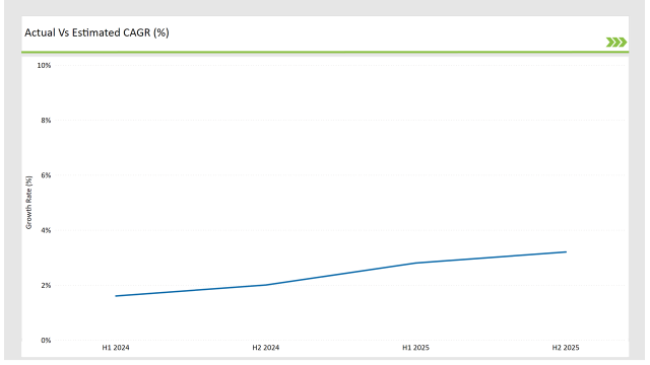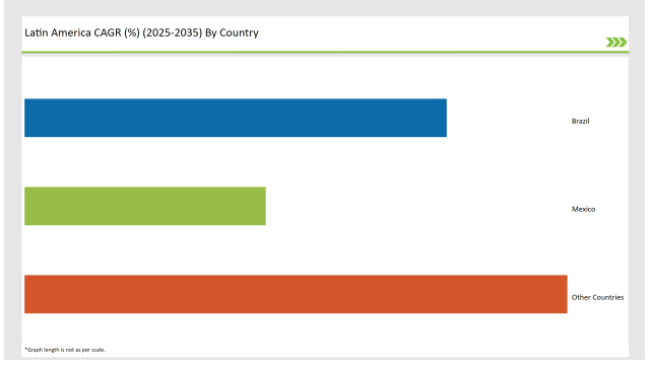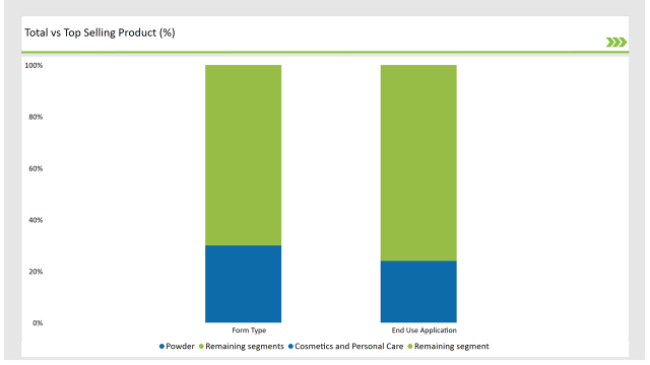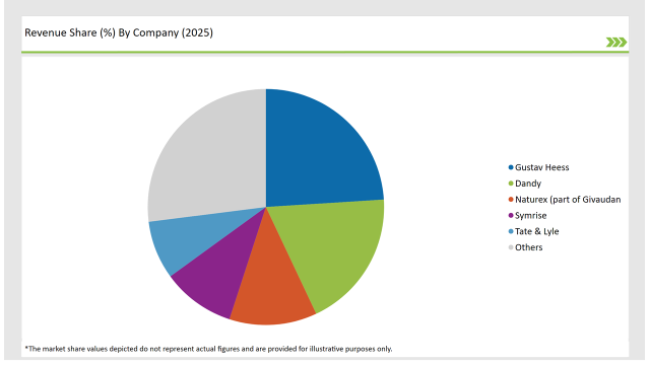The Latin America Licorice Root Sales is set to grow from an estimated USD 170.0 million in 2025 to USD 298.8 million by 2035, with a compound annual growth rate (CAGR) of 5.8% during the forecast period from 2025 to 2035.
| Metric | Value |
|---|---|
| Estimated Latin America Industry Size (2025E) | USD 170.0 million |
| Projected Latin America Value (2035F) | USD 298.8 million |
| Value-based CAGR (2025 to 2035) | 5.8% |
Driven by the rising need for naturally herbal substances in food, beverages, and health remedies, the Latin American licorice market is on the way for norms upturn. With consumers of the area still seeking plant-based diets, licorice root becomes more and more preferred thanks to its relief role on indigestion and its anti-inflammatory nature.
This push is further supported by the increase in consumer knowledge regarding the bad influence of using synthetic additives in food and cosmetics, leading them to prefer natural and organic alternatives.
The market will be fueled by the increased applications of licorice root in products such as herbal teas, functional beverages, and natural sweeteners. Moreover, the growing consumer behavior of utilizing natural skin care products and cosmetics that contain licorice extract while highlighting its soothing and anti-aging effects will also add to the market's rise.
Key areas including Mexico and Brazil, are forecasted to have a rise in the consumption of licorice-containing products, as demand for herbal supplements and natural health remedies continues with growing.
Despite the complications in the licensing process and the need for definite cultivation methods, the future for the licorice in Latin America is bright because of the imported licorice root from China and Turkey that is needed for the increasing demand.
The table below provides a comprehensive analysis of the compound annual growth rate (CAGR) fluctuations over six months for the Latin American Licorice Root market, comparing the base year (2024) and the current year (2025).
This semi-annual report highlights significant market shifts, offering valuable insights into revenue trends and investment opportunities. It helps investors gain a clearer understanding of the market’s growth trajectory within the year. The first half of the year (H1) covers January to June, while the second half (H2) spans July to December.
| Particular | Value CAGR |
|---|---|
| H1 2024 | 1.6% (2024 to 2034) |
| H2 2024 | 2.0% (2024 to 2034) |
| H1 2025 | 2.8% (2025 to 2035) |
| H2 2025 | 3.2% (2025 to 2035) |

H1 signifies period from January to June, H2 Signifies period from July to December
For the Latin American Licorice Root market, the sector is predicted to grow at a CAGR of 1.6% during the first half of 2024, with an increase to 2.0% in the second half of the same year. In 2025, the growth rate is anticipated to slightly decrease to 2.8% in H1 but is expected to rise to 3.2% in H2.
Outrunning Interest in Natural Health Products
A noticeable demand for herbal health products is the main driving force of the licorice root market's growth in Latin America. The consumers have been looking for naturally sourced solutions for carminative, immune system, and anti-inflammatory effects. Licorice root being a prominent part in the creation of herbal teas, supplements, and natural cosmetics is getting traction, especially when the health & beauty market is growing its potential.
The trend also gets support from the flexible health lifestyle that consumers have adopted in Brazil and Mexico, for example using traditional products that are coming back into the market.
Breaking Grounds Utility in Functional Foods and Beverages
In Latin America, licorice root has been finding new application areas in functional foods and beverages. Its employment as a sugar-free sweetener for health drinks including herbal tea and energy drinks is becoming increasingly common as it possesses a sweet flavor without the requirement of added sugar.
The push towards plant-based foods and beverages in the region is also a reason for the higher demand of licorice root as an additive to dairy-free or sugar-free formulas. The desire of the consumers for healthful choices will make the licorice root market high-flying in Latin America glut this upward demand.
The following table shows the estimated growth rates of the top four markets. These countries are set to exhibit high consumption, recording high CAGRs through 2035.

| Countries | Market Share (%) |
|---|---|
| Brazil | 35% |
| Mexico | 20% |
| Other Countries | 45% |
The licorice root market in Brazil and Mexico is witnessing growing demand, with Brazil holding a 35% market share and Mexico accounting for 20%. These two countries are driving much of the growth in the Latin American market due to their increasing interest in natural remedies and herbal-based products.
As the largest market player in the Latin American licorice root sector, Brazil has a 35% share of the market. The country is witnessing a growing demand for herbal teas, natural supplements, and plant-based products. With the trend toward digestive health and anti-inflammatory properties growing, licorice root is now emerging as a common commodity in the wellness sector in Brazil.
On the other hand, the market is also spurred by customers coming from the mainstream population who wants licorice root to use it in place of synthetic ingredients. Brazil, with its long-standing tradition of herbal ingredients, which is a key driver for the use of herbal ingredients licorice in both traditional and modern products, also plays its part.
With 20% of the market share in the licorice root segment in Latin America, Mexico is characterized by a strong demand for natural products and herbal products. Consumers in Mexico are increasingly making use of licorice root as it is known to boost the immune system, i.e., it is soothing, it is a good digestive aid.
The trend of citizens consuming plant-based diets and avoiding sugar in beverages and functional foods promotes licorice root market growth. In addition, Mexico's culture which is rooted in the love of herbal teas and natural sweeteners makes it a crucial player in the introduction of licorice root products in the area.
% share of Individual Categories Form Type and End-Use Application in 2025

| Main Segment | Market Share (%) |
|---|---|
| Form Type (Powder) | 30% |
| Remaining segments | 70% |
Powdered Licorice Root: A Key Segment in the Latin American Market
The powdered form of licorice root holds a 30% market share in Latin America, making it one of the most widely used formats across various industries. This form is preferred due to its versatility, ease of use, and longer shelf life, making it ideal for applications in herbal supplements, functional foods, and cosmetic formulations.
This format is highly choiceable for its easy handling, longer shelf life, and it is convenient to use in products such as herbal supplements, functional foods, and cosmetics.
In food and beverage, licorice root powder is often featured as a sweetener in herbal teas, confectioneries, and plant-based beverages, which corresponds to the trend of reducing sugar and clean label ingredients. Additionally, in the pharmaceutical and nutraceutical industries, licorice root powder is in high demand for its anti-inflammatory effects and promotes digestive health, hence is a key ingredient in herbal remedies and supplements.
Also, the cosmetic and personal care sector are also contributing to the demand for licorice root powder, as it is widely used in anti-aging products due to its brightening and soothing properties. The growing consumer tendency towards functional and natural ingredients will, in the years to come, help power the powdered licorice root market in Latin America.
Growing Demand for Licorice Root in Cosmetics and Personal Care
| Main Segment | Market Share (%) |
|---|---|
| End Use Application (Cosmetics and Personal Care) | 24% |
| Remaining segments | 76% |
Cosmetics and personal care stand for 20% of the total licorice root business in Latin America, which is gaining prominence due to heightened interests in naturally derived and herbal skin care. Licorice root extract is extensively used in brightening creams, treatments for inflammation, and in anti-aging products besides the known property of decreasing hyperpigmentation, soothing irritation, and reducing greenhouse gas.
With the shift of consumers in Latin America to clean beauty and plant-based skincare, the licorice root ingredient is being added in moisturizers, serums, face masks, and sunscreens. Its natural anti-oxidant and anti-inflammatory properties make it the best choice for the treatment of environmental sensitive skin like eczema, rosacea, and acne.
In addition, the trend of herbal and Ayurvedic beauty products is gaining ground with many brands using licorice root as a key ingredient in green and cruelty-free beauty products. As more and more skin benefits are revealed, the segment of personal care and cosmetics will grow steadily in the future thus lifting the demand for the licorice root in the Latin American market.
2025 Market share of Latin America Licorice Root manufacturers
| Manufacturer | Market Share (%) |
|---|---|
| Gustav Heess | 24% |
| Dandy | 19% |
| Naturex (part of Givaudan) | 12% |
| Symrise | 10% |
| Tate & Lyle | 8% |
| Others | 27% |

Note: The above chart is indicative in nature
The Latin American licorice root market has a moderate to high concentration level, which holds a combination of global suppliers, regional manufacturers, and herbal ingredient distributors that are competing for market share. There are some significant players that dominate the space with well-established distribution networks, strong product quality, and their capability to meet the higher demand for natural and functional ingredients.
Countries such as Brazil and Mexico are the primary licorice root hubs for imports and distribution and their food, beverage, pharmaceutical, and personal care sectors propel the demand. The market is furthermore being affected by the presence of small, specialized herbal companies that want to be known for their organic, sustainable, and clean-label supply.
Moreover, strategic partnerships between major ingredient suppliers and local distributors and mergers & acquisitions are re shuffling the competitive arena. Given the demand for plant-based solutions, companies expand their product lines, boost their supply chain and invest in innovation thereby solidifying their presence in the area.
As per Form Type, the industry has been categorized into, Powder, Paste, and Liquid Others.
As per End Use Application, the industry has been categorized into Food and Beverage Industry, Tobacco Industry, Pharmaceutical Industry, Cosmetic Industry, and Dietary Supplements.
The Latin America Licorice Root market is projected to grow at a CAGR of 5.8% from 2025 to 2035.
By 2035, the market is expected to reach an estimated value of USD 298.8 million.
Licorice root is widely used in food and beverages (herbal teas, confectionery, and natural sweeteners), pharmaceuticals (digestive health and respiratory treatments), and cosmetics (skin-brightening and anti-inflammatory products).
The market is moderately concentrated, with a mix of global suppliers, regional manufacturers, and specialized herbal product companies competing for market share through innovation, strategic partnerships, and sustainable sourcing.






Full Research Suite comprises of:
Market outlook & trends analysis
Interviews & case studies
Strategic recommendations
Vendor profiles & capabilities analysis
5-year forecasts
8 regions and 60+ country-level data splits
Market segment data splits
12 months of continuous data updates
DELIVERED AS:
PDF EXCEL ONLINE
Latin America Joint Compound Industry Analysis Size and Share Forecast Outlook 2025 to 2035
Latin America In-mold Labels Market Size and Share Forecast Outlook 2025 to 2035
Latin America Rigid Industrial Packaging Market Size and Share Forecast Outlook 2025 to 2035
Latin America Hand Sanitizer Market Size and Share Forecast Outlook 2025 to 2035
Latin America Hand Soap Market Size and Share Forecast Outlook 2025 to 2035
Latin America Hydraulic Filtration Market Size and Share Forecast Outlook 2025 to 2035
Latin America Automotive HVAC Market Size and Share Forecast Outlook 2025 to 2035
Latin America Frozen Ready Meals Market Insights – Demand & Forecast 2025–2035
Latin America Fish Protein Market Trends – Size, Growth & Forecast 2025–2035
Latin America Aqua Feed Additives Market Trends – Growth & Forecast 2025–2035
Latin America Collagen Peptide Market Report – Trends, Size & Forecast 2025–2035
Latin America Bubble Tea Market Outlook – Growth, Trends & Forecast 2025–2035
Latin America Shrimp Market Report – Trends, Growth & Forecast 2025–2035
Latin America Animal Feed Alternative Protein Market Analysis – Growth & Forecast 2025–2035
Latin America Cultured Wheat Market Outlook – Growth, Demand & Forecast 2025–2035
Latin America Fructo-Oligosaccharides Market Report – Trends & Forecast 2025–2035
Latin America Starch Derivatives Market Outlook – Growth, Demand & Forecast 2025–2035
Latin America Sports Drink Market Analysis – Demand, Size & Forecast 2025–2035
Latin America Calf Milk Replacer Market Insights – Size, Growth & Forecast 2025–2035
Latin America Non-Alcoholic Malt Beverages Market Trends – Growth & Forecast 2025–2035

Thank you!
You will receive an email from our Business Development Manager. Please be sure to check your SPAM/JUNK folder too.
Chat With
MaRIA